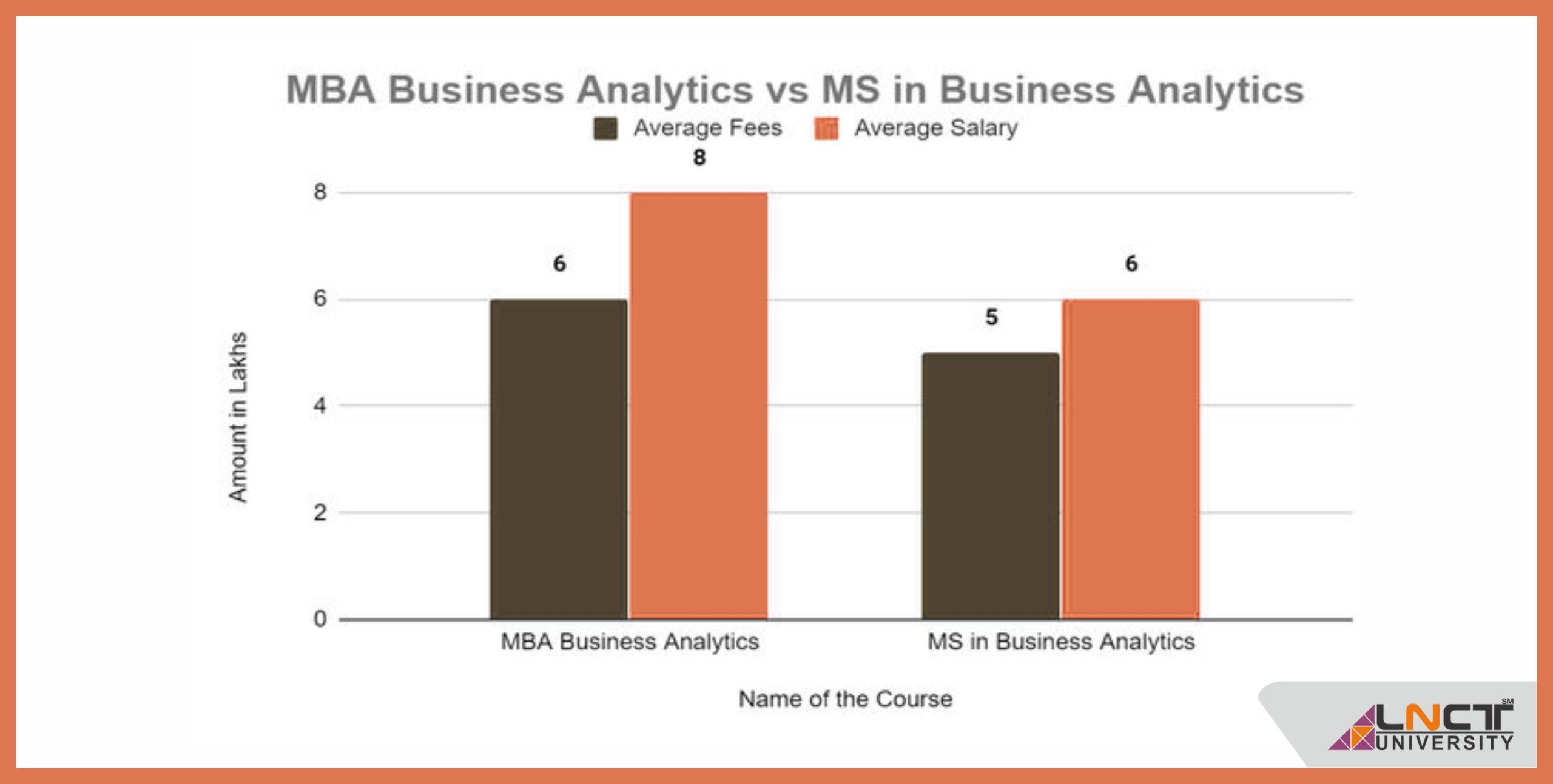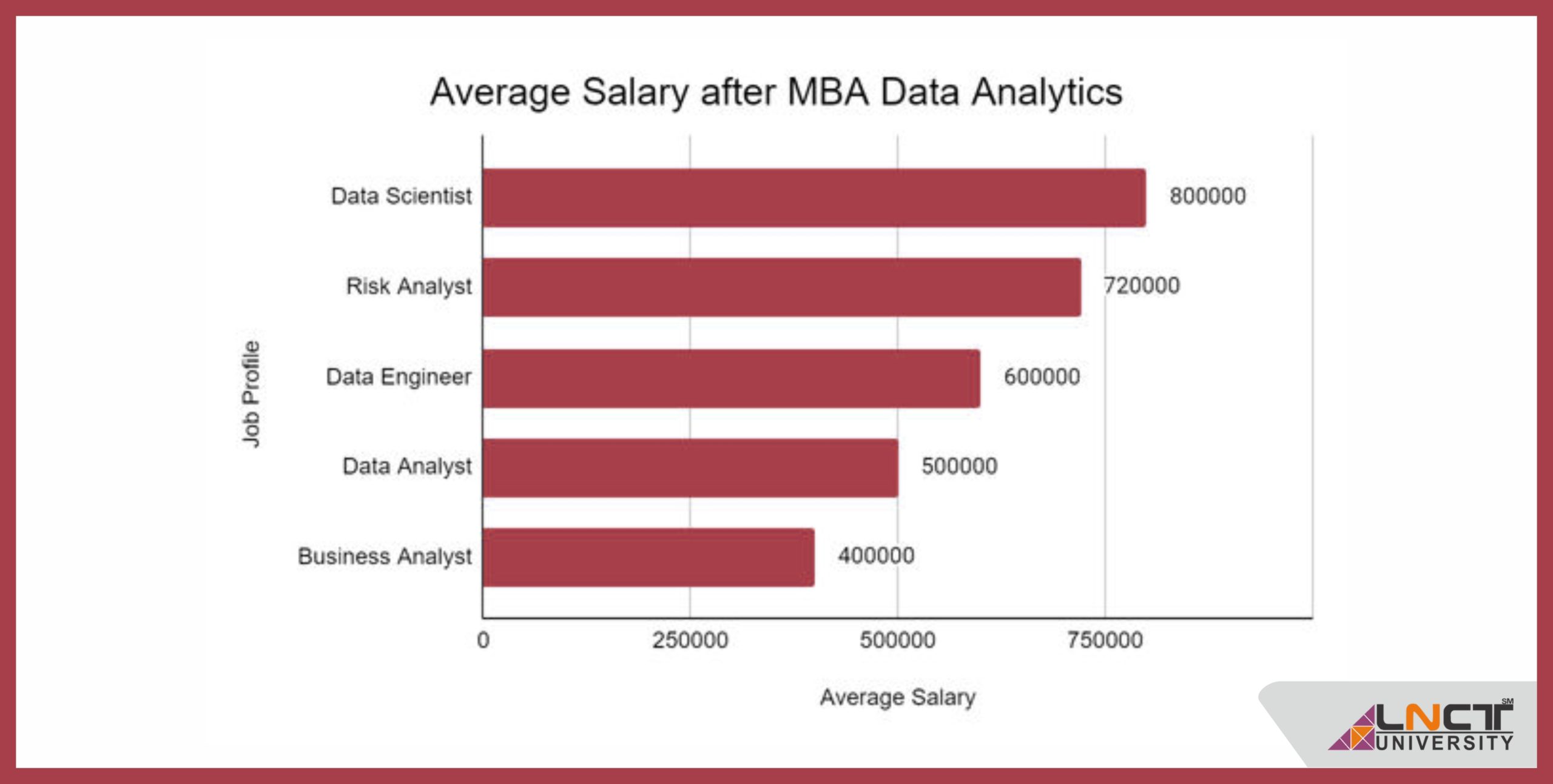MBA in Data Analytics and Visualization and its Career, Growth by 2025
The field of data analytics is a rapidly growing and evolving area. It deals with the extraction, analysis, and presentation of information in a way that helps to answer questions or solve problems. Data analysts are skilled at analyzing data from many different sources such as social media sites like Facebook, Twitter, Linked In, YouTube, etc., email marketing campaigns, bank transactions, etc. This blog post will explore MBA in Data Analytics and Visualization for MBA students who have an interest in this field.
Designed to help you become a successful Business Analyst, this 2 years MBA program is for you to start career in Analytics. To understand this course, it is advisable to have a foundation level knowledge of business analysis. BA needed to be every industry for business insight.
It will teach you how to understand data fundamental, analyse the data methodology, techniques, Python using business case studies, powerful dashboards, Power BI & Tableau Data Visualization powerful tool of data along with a strong focus on business case studies such as TV, Print, Radio, OOH to ensure hands on learning.
Data analytics has proven its worth time and again by helping businesses examine structured and unstructured datasets and extract useful information so key stakeholders can make more-informed, more effective decisions. Analytics can be prescriptive, predictive, diagnostic, and/or descriptive to produce insights, observe trends, compare metrics, and more.
But it can only do so much. Endless columns and rows of alphanumeric data can be difficult to digest at scale. Depending upon the level of detail that stakeholders need to draw actionable conclusions, as well as the need to interact with or drill-down into the data, traditional data analytics might not be sufficient for businesses to excel in today’s competitive marketplace. Additional tools are needed to help extract timelier, more nuanced, and more interactive insights than data analysis alone can provide.
Data Analytics and Visualization
The graduate & Post graduate Engineering programmers in Data Analytics at LNCT University are about providing an innovative education filled with discovery, and dissemination of knowledge.
The reason data analytics is limited might be simple enough. Data analytics helps businesses understand the data they have collected. More precisely, it helps them become cognizant of the performance metrics within the collected data that are most impactful to the business. And it can provide a clearer picture of the business conditions that are of greatest concern to decision-makers.
Additional Information
Data analytics is an important skill that every MBA should have. It’s one of the most sought-after skills in the market today, and it will only become more so over time. With data analytics, you can manage large amounts of information quickly and efficiently to make better business decisions – helping organizations succeed where others might not be able to do as well without this specialized expertise.
One-way data analysis can help a company grow is by determining which products or services are underperforming based on customer preferences or needs with little overhead costs. Thanks to machine learning, your computer does all the heavy lifting for you!
Using artificial intelligence (AI) technologies such as deep neural networks and natural language processing, computers can now sift through massive amounts of data, find patterns and make predictions.
Scope in Data Analytics and visualization:
– Data Analyst
– Business Analyst
– Business Intelligence
– Reporting Analyst
– Financial Analyst
-Marketing Analytics
-Data Visualization Expert
-Tableau Analyst
-Python Analyst
– Digital Analyst
-Consumer Behavior Analyst
– Sales Analyst
– Data Scientist
– Data Consultant
– Management Consultant
& Many more
It is widely accepted that data analysis and visualization will be a key component to any company’s success. Today, there are many tools on the market which can provide benefits for both big and small businesses alike. Some of these include machine learning, deep neural networks, natural language processing, or NLP, among others.
With so much opportunity available in this field today it makes sense to educate oneself on some of the basics. This way when you see an advertisement for software with those features you know what they do! So let’s dive a little deeper into these and what they mean.
Data analytics is the process of analyzing data to gain insights for better decision-making or prediction. It involves using statistics which can be applied to explore information from different fields. This field has grown exponentially with the increase in available tools and technologies as well as people’s reliance on data when it comes to decisions about their work-life, health care spending, investments, etc.
The most common tool for this type of analysis is SQL (structured query language) -a programming language used by database management systems. With that skill, you could get an entry-level job at many companies where your skill set would help them understand trends, create new products based on market needs/gaps, and optimize their operations. The benefits of a degree in Data Analytics are endless; from starting your own business to working in the field, they will give you an advantage over many other candidates.
Data analytics is defined as using statistical methods to explore information for better decision-making or prediction. With all this data available it has become increasingly important for companies/organizations to use statistics to understand trends, create new products based on market needs/gaps, and make decisions that increase efficiency.
SQL (Structured Query Language) -a programming language used by database management systems- is the most common tool for this type of analysis, which can be applied within any number of fields such as marketing research or healthtoding. With a Data Analytics degree, you will learn how to take raw data and explore it in order to find patterns, predict trends or make decisions. This skill is essential for virtually any organization/company that needs this ability.
Scope for MBA in Data Analytics and Visualization
Data analytics and visualization can be a great way for students to enter the business world. A bachelor’s degree in data analytics can qualify you for positions such as analyst, statistician, or database administrator.
A master’s degree can qualify you for a position such as director of analytics or data scientist.
Prerequisites for MBA in Data Analytics and Visualization
Most bachelor’s degree programs in Data Science require at least two years of rigorous study with courses like programming languages (such as Java or C++), mathematics (usually calculus), statistics, accounting/finance along with other business-related subjects depending on the program chosen – often requiring students to have a high GPA.
Some master’s degree programs in Data Science require applicants to have a bachelor’s or master’s degree with no more than two years of work experience, and some programs are targeted towards those who want to be data science leaders.
Application Process
The application process for an MBA in Data Analytics and Visualization program is typically standardized across the board – requiring potential candidates to apply online through schools’ websites usually including GMAT scores (taken independently) along with transcripts from all undergraduate and graduate institutions attended as well as letters of reference/recommendation, essays on why they want the specific business school (and not just any MBA), resumes detailing their professional career thus far and what makes them stand out among other applicants, salary requirements if looking at fellows
This blog post is to be used as a guideline for people that want to apply data science, math and statistics skills to work on visualizations. Individuals will learn how they can use Python libraries like matplotlib or NumPy in order to create interactive graphs. The visualization will allow you to explore the graph by hovering over any point of interest. You’ll also get an idea of what it’s like when modeling surfaces with different mathematical functions using geometric objects called patches (or meshes).
Data analytics course syllabus, subject details, recommended books, skills:
Python: an introductory computer programming language that is easy to learn, powerful.
What you can do with Python skills: Data scientist, data analyst, software engineer, or developer. Some of the jobs related to Python skills are listed below. You need more than just a few years’ experience for many positions and some employers will want candidates with programmer in-residence experience as well;
Data Analyst – using statistical techniques like regression analysis and machine learning algorithms such as K Nearest Neighbors (KNN) classification, decision trees etc., they extract insights from datasets by finding patterns on what is happening now or over time. They may also use SQL queries to analyze web server logs or other big data sets stored on Hadoop clusters.;
Data Scientist – Data scientists use their knowledge of statistics, math and computer science to design experiments that can help make predictions about future events. They might work in areas such as machine learning or natural language processing;
Software Developer – software developers do the hands-on programming necessary for designing new features and dealing with any bugs found after release. They also may be involved in developing a product’s architecture, advising on its general direction, carrying out quality assurance (testing) procedures, etc.;
Developer Evangelist – developer evangelists share insights into what is happening at their company by blogging, podcasting and speaking at conferences. The aim is often to increase awareness of products they are passionate about whilst championing best practices across an industry sector.;
Python Developer – Python is a programming language that has become popular for both its simplicity and the wide variety of libraries available. This makes it an ideal choice for beginners to learn, as well as people who want quick solutions or need to prototype quickly.;
Full Stack Developer – full stack developers are responsible for all facets of design to build web-based applications from frontend presentation through backend business logic;
Data Scientist – data scientists use advanced statistical techniques based on modelling, simulation, and prediction with various computing tools such as MATLAB, SAS, etc. They may also be experts in predictive models which can help identify patterns in large datasets.;
Machine Learning Expert– Machine learning refers to programs capable of improving their performance without being explicitly programmed., ML describes a wide range of techniques that enable computers to learn from data
Data Visualization Expert- Data visualization experts are responsible for creating graphs, charts, and other analytical tools to make sense of large datasets.;
Software Engineer – Software engineers work on projects with a high degree of complexity. They need both technical understanding as well as good business knowledge in order to be successful. A software engineer is capable of designing and developing new applications or improving existing ones through the use of programming languages such as C++, Java etc.,
Web Developer– Web developers are primarily concerned with frontend design aspects while back-end development focuses on databases (SQL), server architecture, network infrastructure and more;
Languages HTML|CSS |JAVASCRIPT |SQL|PHP) Data analytics is an emerging field that has seen significant growth in recent years. Data analytics is the science of deriving meaning and knowledge from data collected by instruments such as sensors or weblogs, particularly for business purposes. Scientific disciplines whose focuses include data analytics:
Data Visualization – a user interface that enables users to explore and analyze large sets of multidimensional data, typically interactively with an emphasis on visual representation rather than numeric display; Software Engineering- Web Developers – Data Analytics | Programmers
Software Engineer- software engineers work on projects with a high degree of complexity. They need both technical understanding as well as good business knowledge to be successful.;Web Developer–web developers
Possible Resume Objectives:
- Become proficient in Python libraries like matplotlib and Numpy for data analytics use cases as well as creating graphs with interactive visualization. [Be able to] model surfaces using different mathematical functions (or meshes)
- Able to quickly learn new programming languages or software packages, which is needed in the evolving field of computer science.
Salary and Jobs in MBA in Data analytics and visualization
MBA in Data analytics and visualization is projected to grow 16% from 2016-2026, which is much faster than the average of other occupations.
Industries in which data analytics and visualization professionals are employed include engineering, telecommunications, finance, computer systems design, or related services. As a result of an increase in the number of companies collecting larger amounts of data to generate competitive intelligence and strategic marketing insights, companies need qualified individuals with strong analytical skills to make sense of all that information.
Data analytics positions require expertise not only in statistics and mathematics but also database management system integration as well as understanding different software packages (e.g., SAS). Visualization concerns both creating graphics for presentation purposes through statistical analysis using programming languages like Python and matplotlib; visualizing those graphics by interacting with them on screen so they can be explored from multiple angles at once; applying spatial relationships between objects within graphs and maps; and the use of color in graphics to enhance understanding.
An MBA in Data Analytics and Visualization With a concentration in data analytics is an excellent way for students to learn how big datasets are mined, analyzed, and communicated – from start to finish.
Read More about : – How to set up a Career in Big Data Engineering | Step-by-step guide
In today’s marketplace, companies need qualified individuals skilled at analyzing large amounts of complex information – often referred to as Big Data – so they can better understand customer needs and make informed decisions about product development or strategy. Data analysts must have deep expertise not only in statistics and mathematics but also database management system integration as well as knowledge of different software packages (e.g., SAS).
Visualization professionals create both static charts used primarily for presentation purposes through statistical analysis using programming languages like Python and matplotlib; interactiveThe marketing and business world is changing quickly. Data analytics and visualization are rapidly becoming the best way to understand trends in your company’s industry, customer base, competition, revenue streams, or costs.
Eligibility for MBA in Data Analytics and Visualization:
Bachelor’s degree in computer science or related field with a strong background in math and statistics (Advanced Placement Calculus) that also includes coding skills such as Python for Data Analytics and Visualization. Additional courses required may include linear algebra, trigonometry, matrix analysis, differential equations, and programming languages such as C++ or Java.
Other requirements may be desired depending on company needs but are not necessary for most data analytics positions like knowledge of statistical methods including multivariate calculus.
In general, an MBA will have obtained many of these needed qualifications through undergraduate coursework already completed by the time they graduate so it would not be necessary to retake the courses before applying.
- Computer Science or related field with a strong background in math and statistics (Advanced Placement Calculus) that also includes coding skills such as Python for Data Analytics and Visualization
- Additional courses required may include linear algebra, trigonometry, matrix analysis, differential equations, and programming languages such as C++ or Java
- Knowledge of statistical methods including multivariate calculus is not usually needed but can improve your chances of getting hired depending on company needs. This qualification could come from undergraduate coursework already completed by the time you graduate so it would not be necessary to take these courses again before applying for data analytics positions. The MBA will have obtained many of these qualifications through their undergraduate coursework.
An MBA in Data Analytics and Visualization is a graduate degree program that can be pursued online or on-site at accredited universities around the world. This course of study focuses primarily on statistical methods, data collection, analysis, modeling, visualization techniques for decision-making purposes such as marketing campaigns to increase revenue, and other topics related to business management skills.
The MBA may also include courses designed with an emphasis on coding skills that also include programming languages like Python for Data Analytics and Visualization .
Additional MBA courses may include linear algebra , trigonometry, matrix analysis, differential equations, and more depending on company needs or desired job functions. Knowledge of these subjects could come from undergraduate coursework already completed by the time you graduate so make sure you talk to your advisor about what classes would be best for this major.
Mba in Data Analytics and Visualization coursework is usually divided into core courses that are common across all business majors such as managerial economics, marketing, finance, leadership, or quantitative methods and specialized courses chosen by the student in their area of interest. The MBA may also include a capstone project on data analytics with an emphasis on visualization skills which could lead to advanced employment opportunities at start-up companies like Uber or Lyft that use these techniques extensively.




